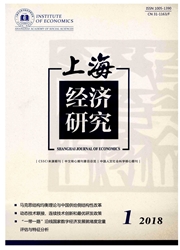

 中文摘要:
中文摘要:
中央银行的外汇干预行为特征一直是学术界和业界关注的热点。2012年4月中央银行再次启动汇改进程,扩大单日人民币汇率浮动区间,但自2012年9月后,人民币兑美元汇率频繁涨停,出现“有价无市”现象,导致外汇市场陷入僵局。在一度授意商业银行购汇之后,央行终于从幕后走到台前,恢复入市干预。将央行外汇干预行为的研究进一步推向高潮。为了准确描述外汇干预行为的非对称性和异方差性特征,本文结合m-机制TR模型和GARCH模型构建起一个m-机制TR—GARCH模型,并对中央银行1996年1月至2013年5月的外汇干预行为特征进行实证考察。研究结果表明,相对于m-机制TR模型而言,m-机制TR—GARCH模型能够更好地描述中央银行外汇干预行为的异方差性特征;在模型的拟合效果和预测效果方面,2-机制TR—GARCH模型优于其它m-机制TR—GARCH模型;同时,2-机制TR—GARCH模型的门限变量为“汇率波动情况”,说明中央银行进行外汇干预的触发因素为汇率波动;另外,2-机制TR—GARCH模型R2机制中目标汇率偏离程度和汇率波动的系数显著,证明中央银行外汇干预的目标是“逆风向干预”和“熨平汇率波动”。
 英文摘要:
英文摘要:
The characteristics of central bank's foreign exchange intervention behavior has been the focus of the academy and industry. In April 2012, the central bank started the exchange reform process again, and expanded the floating range of the RMB exchange rate. But, since September 2012, the RMB against US dollar reached the limit frequently, and a phenomenon of "the city has no price" appeared, resulting the foreign exchange market sank into impasse. For a time instructed commercial banks to purchase the foreign exchange, the central bank finally emerged from the backstage, and restored intervention in the foreign exchange market. Then the research of the central bank's foreign exchange intervention behavior goes to another height. In order to accurately describe the asymmetry and heteroscedasticity of the central bank's foreign exchange intervention behavior, this paper propose a m - regime TR- GARCH model which is combined m -regime TR model with GARCH model to investigate the central bank's foreign exchange intervention behavior from characteristics January, 1996 to May, 2013. The empirical result shows that m -regime TR -GARCH model can describe the heteroscedasticity of the central bank's foreign exchange intervention behavior when compared with m -regime TR model. What's more 2 - regime TR - GARCH model performs better than other m - regime TR - GARCH model in the aspects of model fitting and forecasting; The threshold variable of the 2 , regime TR, GARCH model is exchange rate fluctuations, which indicates that the triggering factor of the central bank's foreign exchange intervention is is exchange rate volatility; What's more, the target exchange deviation and exchange rate volatility's coefficients are significant, which reflects that the main goal of central bank's foreign exchange intervention are " leaning against the wind " and " smoothing exchange rate fluctuations".
 同期刊论文项目
同期刊论文项目
 同项目期刊论文
同项目期刊论文
 Learning, Pricing, Timing and Hedging of the Option to Invest for Perpetual Cash Flows with Idiosync
Learning, Pricing, Timing and Hedging of the Option to Invest for Perpetual Cash Flows with Idiosync A New Method for Setting Futures Portfolios’ Maintenance Margins: Evidence from Chinese Commodity Fu
A New Method for Setting Futures Portfolios’ Maintenance Margins: Evidence from Chinese Commodity Fu The expected discounted penalty function for two classes of risk processes perturbed by diffusion wi
The expected discounted penalty function for two classes of risk processes perturbed by diffusion wi Cross-correlations between WTI crude oil market and U.S. stock market: A perspective from econophysi
Cross-correlations between WTI crude oil market and U.S. stock market: A perspective from econophysi Utility-Based Pricing, Timing and Hedging of an American Call Option under an Incomplete Market with
Utility-Based Pricing, Timing and Hedging of an American Call Option under an Incomplete Market with Almost Everywhere Convergence of Riesz Means Related to Schrodinger Operator with Constan Magnetic F
Almost Everywhere Convergence of Riesz Means Related to Schrodinger Operator with Constan Magnetic F Correlation structure and dynamics of international real estate securities markets: A network perspe
Correlation structure and dynamics of international real estate securities markets: A network perspe Optimal Proportional Reinsurance and Investment Problem with Constraints on Risk Control in a Genera
Optimal Proportional Reinsurance and Investment Problem with Constraints on Risk Control in a Genera On the expected discounted penalty function for the classic risk model with potentially delayed clai
On the expected discounted penalty function for the classic risk model with potentially delayed clai 期刊信息
期刊信息
